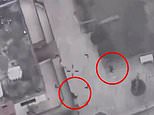WHAT ARE THE ORIGINS OF HEZBOLLAH?
Iran’s Revolutionary Guards founded Hezbollah in 1982, during the 1975–90 Lebanese civil war, as part of Tehran’s efforts to export its 1979 Islamic Revolution and fight Israeli forces that had invaded Lebanon in 1982. The group has grown from a shadowy faction into a heavily armed force with major influence in Lebanon and the region. It is considered a terrorist group by Western governments, including the United States, as are Sunni Gulf Arab states, including Saudi Arabia.
Hezbollah is a Shiite Islamist group and shares the ideology of the Islamic Republic of Iran.
HOW DID HEZBOLLAH GET INVOLVED IN THE GAZA WAR?
Hezbollah is a powerful part of the “Axis of Resistance,” an alliance of Iran-backed groups across the Middle East that also includes the Palestinian Islamist movement Hamas, which launched the Gaza war by attacking Israel on Oct. 7. Declaring solidarity with the Palestinians, Hezbollah began firing on Israeli positions in the border region on Oct. 8. Since then, the sides have exchanged fire on a near-daily basis, with Hezbollah launching rockets and drones and Israel mounting air and artillery strikes. The attacks have mostly taken place near or on the border, but both sides have also expanded their attacks.
Tens of thousands of people have been uprooted in Lebanon and Israel.
How powerful is Hezbollah’s army?
While other groups disarmed after Lebanon’s civil war, Hezbollah kept its weapons to fight Israeli forces occupying the predominantly Shiite south of the country. Years of guerrilla warfare led Israel to withdraw in 2000, but Hezbollah kept its arsenal.
Hezbollah demonstrated military advances in 2006 during a five-week war with Israel, which erupted after it crossed into Israel, kidnapping two soldiers and killing others.
Hezbollah fired thousands of rockets at Israel during the conflict, which killed 1,200 people in Lebanon, mostly civilians, and 158 Israelis, most of them soldiers.
Hezbollah’s military power grew after 2006. The group claims its rockets can reach any part of Israel and that its arsenal includes precision missiles. During the Gaza war, Hezbollah has announced attacks with surface-to-air missiles, a weapon it was long believed to have in its arsenal but never previously confirmed. It has also launched explosive drones at Israel.
Hezbollah leader Sayyed Hassan Nasrallah has said the group has 100,000 fighters. The CIA World Factbook estimates that by 2022 Hezbollah would have 45,000 fighters, divided between about 20,000 full-timers and 25,000 reservists.
WHAT REGIONAL INFLUENCE DOES HEZBOLLAH HAVE?
Hezbollah has inspired and supported other Iranian-backed groups across the region, including Iraqi Shiite militias. It played a major role in helping its ally, President Bashar al-Assad, fight the war in Syria, where it still has fighters. Saudi Arabia says Hezbollah has also fought in support of Iran-allied Houthis in Yemen. Hezbollah denies this.
WHAT IS HEZBOLLAH’S ROLE IN LEBANON?
Hezbollah’s influence is based both on its weapons and on the support of many Lebanese Shiites who say the group is defending Lebanon from Israel. It has ministers in the government and lawmakers in parliament.
Lebanese parties opposed to Hezbollah say the group has undermined the state and unilaterally dragged Lebanon into wars.
He entered Lebanese politics in 1992, running in elections, and began to take a more prominent role in state affairs in 2005 after Syria withdrew its forces from Lebanon following the assassination of former Prime Minister Rafik al-Hariri, a Sunni politician who symbolized Saudi influence in Beirut.
A UN-backed court convicted three Hezbollah members in absentia for the killing. Hezbollah denies any involvement and describes the court as a tool of its enemies.
In 2008, a power struggle between Hezbollah and its Lebanese political adversaries erupted into armed conflict after the government vowed to crack down on the group’s military communications network. Hezbollah fighters seized control of parts of Beirut.
In 2018, Hezbollah and its allies who support its possession of weapons won a parliamentary majority that they lost in 2022, but the group still has great political influence.
ACCUSED OF ATTACKS ON WESTERN INTERESTS
Lebanese officials and Western intelligence services have said Hezbollah-linked groups carried out suicide attacks against Western embassies and targets and kidnapped Westerners in the 1980s.
The United States blames Hezbollah for the 1983 suicide bombings that destroyed the US Marines’ headquarters in Beirut, killing 241 soldiers, and a French barracks, killing 58 French paratroopers. It also says Hezbollah was behind a suicide attack on the US embassy in Beirut in 1983.
Referring to those attacks and hostage-takings, Hezbollah leader Hassan Nasrallah said in a 2022 interview that they were carried out by small groups not linked to Hezbollah.
Hezbollah has also been accused of militant attacks elsewhere. Argentina blames it, along with Iran, for the deadly bombing of a Jewish community center in Buenos Aires that killed 85 people in 1994 and an attack on the Israeli embassy in Buenos Aires in 1992 that killed 29 people.
Source: Reuters

